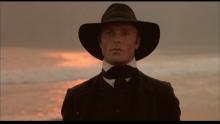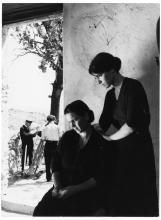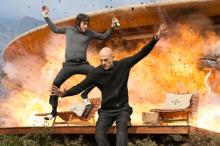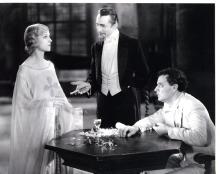These notes on Robert Altman's 3 Women were written by Matthew Connolly, Ph.D. candidate in the Department of Communication Arts at UW Madison. A new 4K restoration of 3 Women will screen as part of our "Robert Altman: Five Masterworks" series on Friday, April 29, at 7 p.m. in the Cinematheque's regular screening venue, 4070 Vilas Hall, 821 University Avenue
By Matthew Connolly
“At the time, of course, I was not aware of it. I don’t sit and think, ‘Oh, I’ll use a female character.’ That’s simply what attracted me. I don’t know if that relates particularly to my own life or experience. I don’t know where that interest in strong female characters comes from.” – Robert Altman, in response to critic Graham Fuller’s observation on how his films which “seem to be making personal statements” often “focus on strong female characters.”
Among Robert Altman’s most formally innovative and narratively beguiling works, 3 Women (1977) offers a particularly fruitful example of the filmmaker’s career-long investment in chronicling female identity and experience. This interest has taken many forms and produced varying representational results throughout his career. At his best, he has helped to create (and, just as importantly, given actresses the space to shape) some of the richest and most vibrant female roles in contemporary American cinema: Constance Miller in McCabe and Mrs. Miller (1971), Linnea Reese in Nashville (1975), Joanne in Come Back to the 5 & Dime, Jimmy Dean, Jimmy Dean (1982), Marian Wyman in Short Cuts (1993), to name just a few. Still, even the most ardent Altman acolyte has assuredly cringed at the abrasive, even cruel treatment that women have sometimes received throughout his oeuvre.
Within this body of work, though, 3 Women stands out both for its almost-exclusive focus on female protagonists and its increasingly mysterious handling of their relationships to one another. A physical therapist at a California health spa for the elderly, Millie (Shelley Duvall) is a socially isolated extrovert whose constant attempts to connect with neighbors and co-workers end in derision. She nevertheless becomes an object of adoration for Pinky Rose (Sissy Spacek), a shy and almost childlike new employee at the spa. The two move in together after Millie’s old roommate moves out, with Millie introducing Pinky to the co-owners of both their apartment building and the bar that Millie frequents: Willie (Janice Rule), pregnant and silent and almost always painting unsetting murals of lizard-like creatures; and her boozy, philandering husband, Edgar (Robert Fortier). A combination of Millie’s blinkered romantic pursuits and Pinky’s blatant attempts to infiltrate herself into Millie’s personal life soon cause friction between the two, leading to a series of bizarre events that cause the personalities of the two women to bleed into one another. To reveal any more to potential first-time viewers is to dampen the elegantly unsettling and slippery maneuvers through which Altman shifts the identities of Willie, Pinky, and Millie. Suffice to say, though, that the Bergman-esque (see Persona, which is screening on May 1) blurring of selves within the film’s second half pushes 3 Women beyond Altman’s usual brand of free-floating, acid-tinged social commentary and into the realm of the surreal.
What to make of the fact – as suggested in the above interview excerpt – that one of Altman’s most explicit forays into art-cinema ambiguity and narrative indeterminacy became so deeply entangled with the mystery of female identity? Critics came up with varying explanations and opinions upon the film’s release in April 1977, with some linking 3 Women’s enigmatic qualities to its well-publicized origins in a dream that Altman had while his wife Kathryn was hospitalized with a duodenal ulcer. In his largely glowing notice, Vincent Canby of The New York Times deemed the film “the moviemaker’s dream more than that of the characters’ within,” adding that “it’s not a narrative in any strict sense but a contemplation of three stages of a woman’s life by a man who appreciates women and may not be without a bit of guilt.” This notion of the film as more male reverie than a contemplation of lived female experience became echoed more critically in articles that discussed the film in relation to larger trends in the representation of women in late-1970s Hollywood. Jane Wilson, also in The New York Times, wrote that 3 Women “speaks powerfully of Altman’s own apprehensions of female nature as it impinges on him in his dreams,” but “hasn’t much to say to women now about themselves, nor does it provide any fresh perceptions about their relationships with one another and with men.”
Historical distance and critical hindsight have done little to resolve such debates. 3 Women’s depiction of the fluctuating friendship between Millie and Pinky possesses all the markers of Altman’s career-long observational acuity, particularly when documenting Millie’s consumerist obsessions fueled by McCall’s and other women’s magazines of the era. (The preparations of her abortive dinner party are a jaw-dropping cavalcade of late-70s processed food.) Yet such comic bite cannot easily be disentangled from Altman’s compassion, especially towards Millie. “She’s simply trying to do the right thing,” Altman told Betty Jeffries Demby in a 1977 interview when discussing Millie’s slavish devotion to all things conventionally feminine, “and what is the right thing? It’s the thing people tell you is right.” In the same interview, his thoughts on the film’s final vision of female solidarity hints at a complicated interweaving of utopian collectivity and unsparing instinct: “The women in 3 Women survive because they are taking care of each other. And they do that because they are forced into it … surviving is stronger than morals. It’s the strongest thing because it’s the least understood and it’s the least logical.”
If the film’s deeply imbricated strands of up-to-the-minute satire and dream logic, anxiety and empathy, ensures that it will remain a productively complicated example of Altman’s larger relationship to female representation, 3 Women also showcases how Altman’s emphasis on collaboration allowed the actresses within his film opportunities to shine that they rarely received elsewhere. Spacek’s perfectly calibrated blankness proves all the more unsettling as Pinky’s obsession deepens and then dissipates, while Duvall (who improvised several of her most memorable monologues) brings such astute comic timing and fierce presence to Millie that her most pedestrian wants and desires take on a shocking depth of feeling. They form an essential center to a film built around ever growing indeterminacy; or, to quote Melissa Anderson, they’re “reminders of a very specific somewhere, the one immutable truth in a film abounding with fantasies.”










